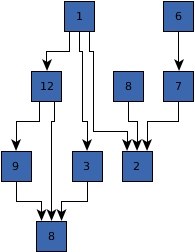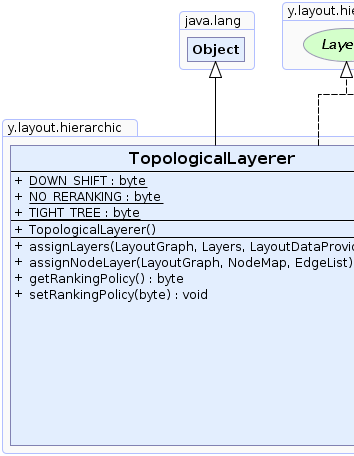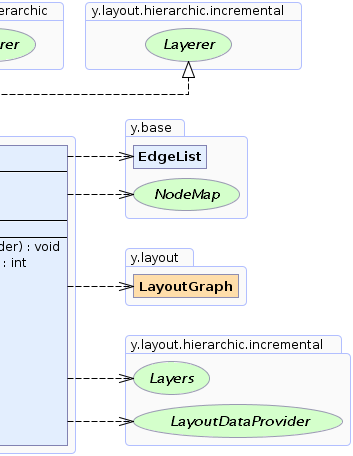 y.layout.hierarchic.TopologicalLayerer
y.layout.hierarchic.TopologicalLayerer
|
Search this API | ||||||||
| PREV CLASS NEXT CLASS | FRAMES NO FRAMES | ||||||||
| SUMMARY: NESTED | FIELD | CONSTR | METHOD | DETAIL: FIELD | CONSTR | METHOD | ||||||||
java.lang.Objecty.layout.hierarchic.TopologicalLayerer
public class TopologicalLayerer
This class implements the layering phase of the IncrementalHierarchicLayouter (i.e., assignment of the nodes to layers).
It uses topological sorting to assign layers to the nodes.

IncrementalHierarchicLayouter as well as HierarchicLayouter and
HierarchicGroupLayouter. |
 |
| Field Summary | |
|---|---|
static byte |
DOWN_SHIFT
A ranking policy that specifies that nodes are re-ranked by an inexpensive downshift rule. |
static byte |
NO_RERANKING
A ranking policy that specifies that nodes are not re-ranked after the initial topological layering step. |
static byte |
TIGHT_TREE
A ranking policy that specifies that nodes are re-ranked by finding a spanning tree that contains only tight (length 1) edges. |
| Constructor Summary | |
|---|---|
TopologicalLayerer()
Creates a new instance of TopologicalLayerer with default settings. |
|
| Method Summary | |
|---|---|
void |
assignLayers(LayoutGraph graph,
Layers layers,
LayoutDataProvider ldp)
Assigns all nodes of the graph to layers and adds them to the Layers instance. |
int |
assignNodeLayer(LayoutGraph graph,
NodeMap layerID,
EdgeList reversedEdges)
This method assigns the nodes in the graph to layers. |
byte |
getRankingPolicy()
Returns the (re-)ranking policy used by this TopologicalLayerer instance. |
void |
setRankingPolicy(byte p)
Specifies the (re-)ranking policy used by this TopologicalLayerer instance. |
| Methods inherited from class java.lang.Object |
|---|
clone, equals, finalize, getClass, hashCode, notify, notifyAll, toString, wait, wait, wait |
| Field Detail |
|---|
public static final byte NO_RERANKING
public static final byte DOWN_SHIFT
public static final byte TIGHT_TREE
1) edges.
| Constructor Detail |
|---|
public TopologicalLayerer()
TopologicalLayerer with default settings.
| Method Detail |
|---|
public void setRankingPolicy(byte p)
TopologicalLayerer instance.
NO_RERANKINGp - one of the predefined ranking policies
java.lang.IllegalArgumentException - if an unknown ranking policy is givenpublic byte getRankingPolicy()
TopologicalLayerer instance.
setRankingPolicy(byte)
public int assignNodeLayer(LayoutGraph graph,
NodeMap layerID,
EdgeList reversedEdges)
(v,w) in E: layer(v) < layer(w)graph - the given graphlayerID - the NodeMap that will be filled by the layout algorithm and returns the zero-based index
of the layer to which each node belongsreversedEdges - an EdgeList containing the edges which had been reversed
public void assignLayers(LayoutGraph graph,
Layers layers,
LayoutDataProvider ldp)
Layers instance.
assignLayers in interface Layerergraph - the input graphlayers - the Layers instance that will be filled with the results of the calculationldp - the LayoutDataProvider used for querying information about the nodes and edgesLayers.insert(byte, int),
Layer.add(y.base.Node)
|
© Copyright 2000-2025, yWorks GmbH. All rights reserved. |
||||||||
| PREV CLASS NEXT CLASS | FRAMES NO FRAMES | ||||||||
| SUMMARY: NESTED | FIELD | CONSTR | METHOD | DETAIL: FIELD | CONSTR | METHOD | ||||||||